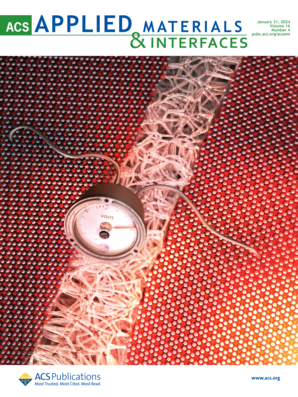原子分散铁位点上不对称配体促进d带中心调控促进氧电催化活性
IF 8.3
2区 材料科学
Q1 MATERIALS SCIENCE, MULTIDISCIPLINARY
引用次数: 0
摘要
由于阴极氧电催化剂的性能不理想,阻碍了锌空气水电池的发展。氧电催化剂的重要催化剂是原子分散的铁原子嵌入氮掺杂碳(Fe-NC)材料中。然而,中心铁原子与反应中间体之间的结合能不合适,导致氧电催化剂反应速率缓慢。通过调整配位结构来调节铁原子的电子结构是一种有效的解决方法。本文论述了氮原子被硫原子取代,硫原子电负性弱,能给铁原子电子,使铁原子的d带中心升高。因此,与Fe-N活性位点相比,Fe-NS活性位点有利于*OOH的快速吸附和*OH的脱附。结果,氧电催化剂的反应动力学加快。Fe-NSC催化剂在水溶液可充电锌空气电池中具有良好的相容性和性能,在10 mA cm-2条件下具有较高的电压容限(0.74 ~ 0.96 V),可提供1000 h/3000次的稳定充放电过程。本工作对m - n - c型催化剂中心原子电子结构的修饰具有参考意义。本文章由计算机程序翻译,如有差异,请以英文原文为准。

d-Band Center Regulation Facilitated by Asymmetrical Ligand in the Atomically Dispersed Iron Site toward Promoting Oxygen Electrocatalysis Activities
The prosperity of aqueous rechargeable Zn–air batteries is hindered by the discontent performance of the oxygen electrocatalyst in the cathode. An important catalyst for oxygen electrocatalyst is an atomically dispersed iron atom embedded in the nitrogen-doped carbon (Fe-NC) material. However, the unsuitable binding energy between the center Fe atom and the reaction intermediate leads to the sluggish oxygen electrocatalyst reaction rate. The regulation of the electron structure of the Fe atom by adjusting the coordinate structure is one effective solution. Here, we prose the substitution of nitrogen atom by sulfur atom, who has weak electronegativity and can donor electron to Fe atom, so the d-band center of Fe atom is elevated. Thus, the Fe-NS active site facilitates the fast *OOH adsorption and the *OH desorption, compared with counterpart Fe-N active site. As a result, the oxygen electrocatalyst reaction kinetics is accelerated. The Fe-NSC catalyst has good compatibility and performance in aqueous rechargeable Zn–air batteries, affording stable charge/discharge process for 1000 h/3000 cycles with a high voltage tolerance (0.74–0.96 V voltage gap) under 10 mA cm–2. This work brings referential sights to the modification of electron structure of the center atom in the M–N–C-type catalyst.
求助全文
通过发布文献求助,成功后即可免费获取论文全文。
去求助
来源期刊

ACS Applied Materials & Interfaces
工程技术-材料科学:综合
CiteScore
16.00
自引率
6.30%
发文量
4978
审稿时长
1.8 months
期刊介绍:
ACS Applied Materials & Interfaces is a leading interdisciplinary journal that brings together chemists, engineers, physicists, and biologists to explore the development and utilization of newly-discovered materials and interfacial processes for specific applications. Our journal has experienced remarkable growth since its establishment in 2009, both in terms of the number of articles published and the impact of the research showcased. We are proud to foster a truly global community, with the majority of published articles originating from outside the United States, reflecting the rapid growth of applied research worldwide.
 求助内容:
求助内容: 应助结果提醒方式:
应助结果提醒方式:


